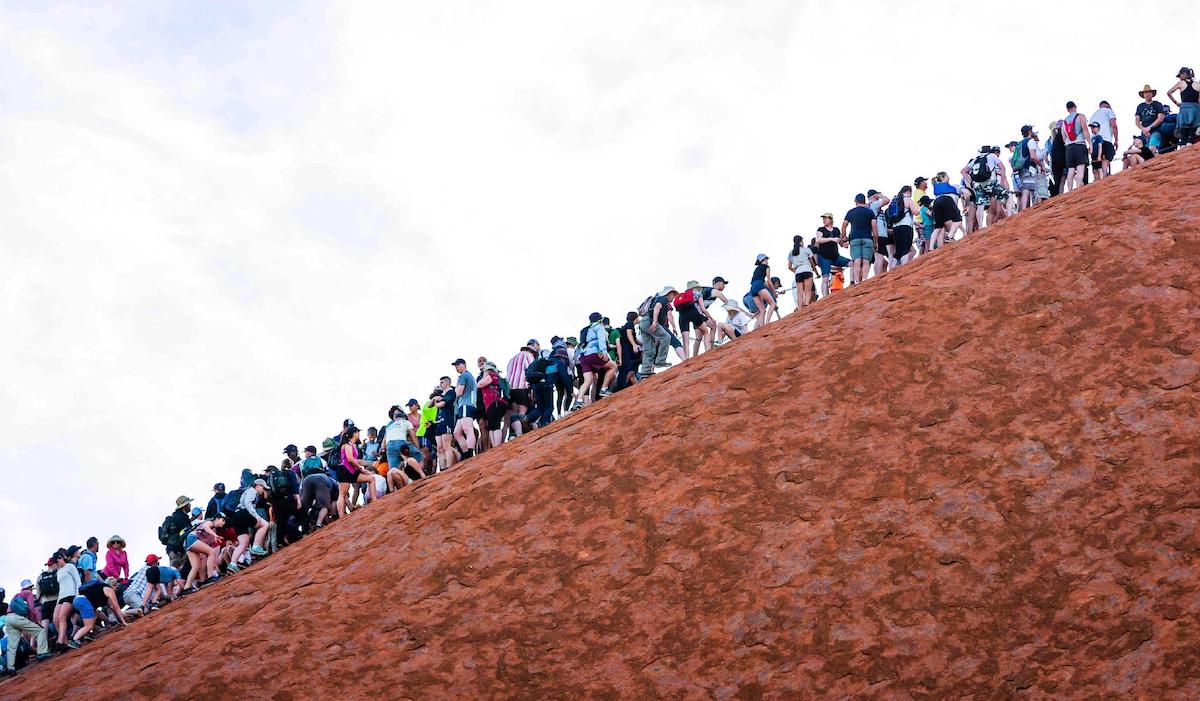There’s a countdown to the ban to climb Uluru, and for many, it’s a long-awaited chance to rejoice. Uluru is the original Aboriginal name given to the massive red rock formation in the middle of Australia. There’s a large chance you’ve probably heard it being called Ayers Rock (the name given to it by the English colonizers when they came across it) or by its less creative title, Red Rock. Rising to 348 meters, Uluru is a World Heritage-listed natural wonder and perhaps, more importantly, considered the spiritual heart of Australia located in the remote expanse of red desert.
What’s important to realize is that while it has become an extremely popular tourist destination, Uluru has always been a sacred site for the Anangu people first. It is protected by Uluru-Kata Tjuta National Park, which is intended to ensure that it is protected as a sacred, culturally significant site and ensure that it remains a space for preserving and passing on traditional stories and histories. For Aboriginal Australians, these stories are not only a way to trace their past but also act as a more powerful connection to ancestors and “country”. Country refers to the deeply rooted relationship between Aboriginals and land, its a spiritual, familial, and physical connection. These stories are so important that the national park insists that all non-Aboriginal guides attend a course to make sure that they tell the Aboriginal stories accurately.
My twin sister and I in Uluru-Kata Tjuta National Park, 2006
My twin sister, mum and I in Uluru-Kata Tjuta National Park, 2006
Back in 2006, I visited Uluru with my family when I was only six and it was an experience marked by red sand and empty landscapes, there were barely any tourists at all. Everything we saw was through the mosquito nets we had thrown over our heads. When I look back at our photos, I realize just how much has changed. The red sand and dusty shrubs have been replaced by tarmac to accommodate the waves of people and convoys of cars. The once faint line of a weathered rock snaking up the side of the monolith that described the trail would be empty, perhaps a couple of tourists braving the heat and ignoring the signs asking for visitors to respect the site and not climb. But now, you can barely see the trail at all due to the sheer number of climbers. Back then the rest of us would take our photos from afar, respecting the space and respecting the culture and watching the few climbers in dismay. Nowadays, I think there are more people taking photos of themselves from the top, and perhaps using their zoom function to capture those few tourists at the bottom who decided to respect the signs.
A climbing ban comes into effect on October 26, 2019, almost 34 years later since the land Uluru stands on was officially handed back to its traditional Aboriginal landowners. When I heard about the ban, I thought finally it was about time! But since my last visit all those years ago, something has changed and not for the better. There are more signs and more people ignoring them. You would imagine that the announcement of this ban would alert many visitors of the deeply rooted significance of the site and make them reconsider scaling the red rock. Instead, there’s been a surge of visitors, in fact, it’s increased by 20% since past years, with all surrounding accommodations being fully booked. This defeats the whole reason for banning it. It’s gotten so bad that visitors have begun to illegally park their campers and pitch tents beside the road, leaving rubbish and disturbing the natural environment.
With fame often comes some misfortune. Even though Uluru is protected by the Uluru-Kata Tjuta National Park and is rimmed with multiple signs asking for visitors not to climb, an increasing number of people have decided to ignore the signs and scale the site. Ever since it first became popular with outsiders in the 1930s, Uluru has become one of Australia’s most distinctive landmarks and top tourist destinations, with countless visitors arriving with the sole aim of following the weathered trail up the red slope.
The ban to climb Uluru will be introduced to protect its cultural significance, but it also addresses several safety concerns associated with the climb. Between 2002 and 2009 74 climbers have needed to be evacuated for medical issues with 36 climbers have died since the 1950s. Despite all this, many oppose the ban, claiming that making climbing illegal will negatively impact tourism in the surrounding remote areas. Sammy Wilson, chairman of the national park board only had this to say: “Whitefellas see the land in economic terms, where Anangu see it as tjukurpa [the ancestral source of being]. If tjukurpa is gone, so is everything.”
This not only highlights conflicts of interest but also exposes some double standards. Around the world, there are various sacred sites ranging from religious buildings and sites to other significant locations. For tourists visiting the Western Wall in Jerusalem or Notre Dame in Paris, there is absolutely no need to add a sign describing how people must act. There are no signs asking visitors not to scale pillars and bricks because people know better, they understand the cultural significance of such locations. For some reason, this same consideration for sacred sites disappears when tourists approach Uluru. Perhaps it is because it is viewed as more of a natural wonder than a sacred site? I couldn’t say, except that as an Australian, I feel that the ban is long overdue.


